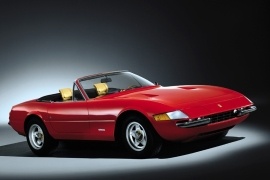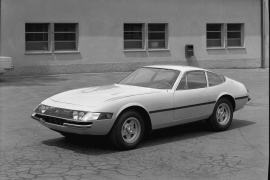FERRARI 365 Models/Series Timeline, Specifications & Photos
First production year: 1968
Engines: Gasoline
Body style: Coupé (two-door)
The Ferrari 365 GTS/4 was also known as the Daytona, celebrating the 1-2-3 victory at the 1967 Daytona race, and it was one of the most revolutionary vehicles in the Italian carmaker history.
Ferrari introduced the GTS/4 as the open-top version for the 365 GTB/4. The name might seem mesmerizing, but it actually said that the engine featured a 365 cubic centimeters/cylinder ant the /4 represented the four cams per cylinder system. Back in the '60s, that was a rare feature reserved only for a few vehicles. The GTS meant Gran Turismo Spider, unlike the GTB, which meant Gran Turismo Berlinetta. But its nickname overtook the official name until it started to be used by everybody.
From the outside, the outrageous GTS/4 featured a sloped front end with pop-up headlights. Leonardo Fioravanti designed the car for the Pininfarina studio, and it was at least a decade ahead of its times. Imagine that some carmakers still used to make fixed, round headlights attached to their cars. The car's long lines, with a gentle wave on the sides with just a small hump over the rear wheels, was a timeless beauty. Its small, round taillights were typical for the Ferrari brand.
Inside, the carmaker installed a luxurious interior with sport bucket seats and wrapped everything with expensive leather. Ferrari installed an aluminum dash panel inside the instrument cluster with eight dials and gauges inside. But the carmaker stated that the 365 GTS/4 was just a Gran Tourismo vehicle, not a supercar, even though it was the fastest car that could be registered for road use.
Under the hood, the Italian engineers installed a 4.4-liter V12 engine that provided 352 hp. It was fed by six carburetors and paired to a 5-speed manual gearbox.
After dominating the podium at the 1967 Daytona race in the U.S., Ferrari considered that that achievement deserved to be mentioned on a vehicle, so it added the event’s location name to the 1968 365 GTB/4 nameplate. It became a hit among American customers.
In the U.S., the muscle car era was riding the high tides, and the American automakers pushed their boundaries to create more powerful vehicles able to break into the magic ten-second time for the quarter-mile race. But Ferrari had a different approach. It offered a true sportscar with a look to kill and performance to dominate a race track, not a straight line.
Despite featuring a smaller displacement engine than many American muscle cars, the 365/4 GTB was very competitive. Furthermore, it was a car designed for those with deep pockets. Besides excellent performance, it added a touch of luxury as well. The car became famous in the U.S. in 1971 after winning the inaugural race across the U.S. from New York to Los Angeles with an average speed of 80.1 mph (129 kph), with Dan Gurney and Brock Yates taking turns behind the wheel.
The car was penned by Leonardo Fiorovanti, who, at that time, worked for the Pininfarina design studio. He imagined a sleek, aerodynamic shape where the round headlights mandatory for the U.S. market were concealed behind an acrylic glass panel covering the parking lights and the blinkers. The hood was almost flat and sported two exhaust vents close to the windshield. The cab rearward design vehicle continued with a greenhouse with wide windows and a sloped-down rear end.
Furthermore, the Italian automaker found a way to install slim-looking bumpers both front and rear, which were still made according to American safety standards. The overall look was slightly different than on the open-top sibling, the GTS/4. GTB stood for Gran Turismo Berlinetta, 365 was the displacement of one cylinder expressed in cubic centimeters, and the /4 meant that the engine featured a four-valve/cylinder technology. But everybody knew it as the Daytona coupe.
But the biggest surprise was inside the cabin, where Ferrari created a 2+2 interior. At the front, the high-bolstered seats featured adjustable headrests and were covered with fine leather. Between the driver and their side passenger, the automaker installed a center console, which housed an ashtray and the gear stick. In addition, the GTB/4 Daytona had a center stack that housed the stereo and the HVAC controls.
Fronting the driver was a neat-looking instrument cluster filled with eight dials, where the speedometer and the rev counter were wider than the other six gauges that accompanied them. In the back, the automaker placed two individual bucket seats, which were offered as an option. Customers could also use that area for storage.
Ferrari installed a 4.4-liter V12 engine under the hood of the 365 GTB/4. While its displacement was way smaller than in most other muscle cars from that era, the car could keep up with them thanks to its low weight and the five-speed manual transmission. Furthermore, it could rev high up to 8,000 rpm.

